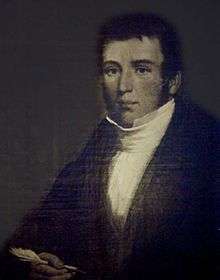Franklin Jackes
| Franklin Jackes | |
|---|---|
 Franklin Jackes, first Warden of York | |
| Personal details | |
| Born |
March 3, 1804 London, England |
| Died |
April 16, 1852 (aged 48) Toronto, Canada West |
| Political party | Reformer |
| Spouse(s) | Catherine Gibson |
| Profession | Baker, Politician |
Franklin Jackes (March 3, 1804 – April 16, 1852) was an early Torontonian politician of the Reform movement.
Early life
Franklin Jackes was born in London, England, the third child of William Jackes and Catharine Palmer. He had a twin brother who was named Napoleon, but who died in infancy. At the age of eight Franklin Jackes moved with his family to New York City in 1812, however he returned to Europe to serve in the army of the Duke of Wellington as an apprentice baker during the Battle of Waterloo.[1] He then returned to New York City and subsequently moved to Toronto with his family in 1817. There he became a baker, known in particular for his high-quality horse cakes which were sold for half a penny each.[1] In 1825, while walking along the harbour of Toronto he encountered the wealthy miller Benjamin Thorne who was offering to sell his fleet of flour for five pounds, at such a low price because he believed that it had sunk in Lake Ontario due to its extreme tardiness.[2] Franklin Jackes agreed to buy his wares, and the fleet arrived the same afternoon, making him a wealthy man.[1] In the spring of 1842, he bought a house known as Castlefield from a prominent Torontonian lawyer and politician named James Hervey Price for the price of 985 Spanish dollars, as well as other large amounts of land in modern-day Toronto.[3] Franklin Jackes married Catherine Gibson (February 28, 1808 – November 18, 1886) at Niagara-on-the-Lake on November 11, 1825 at the age of 19. They remained married until his death and had eleven children, one of whom was Albert G. Jackes, a doctor in the army of William McDougall and member of the Council of Keewatin, in modern-day Manitoba.[4] Franklin Jackes was a good friend of James Hervey Price, and named one of his children Price in his honour. His wife Catherine Jackes also adopted two more children after her husband's death.
Political career
Franklin Jackes was a devout Reformer before and during the Upper Canada Rebellion of 1837, and was a supporter and personal friend of William Lyon Mackenzie.[5] He was a member of the Committee of 1 000 which asked Sir John Colborne to dissolve parliament in 1831,[5] and was elected to Toronto’s first city council to represent St. David's Ward in 1834. In that year he moved to have Mackenzie elected as the first mayor of Toronto by the council.[6] He was also commissioned as a justice of the peace in 1837, despite having taken part in the Upper Canada Rebellion in the same year.[7] He was also a member of the Toronto Agricultural Committee, and was the first warden of the York County, Ontario for two terms from 1850–1851, as well as the first reeve of the Township of York for the same period.[7] His eldest son, William Jackes, also served on the council of the Township of York and was elected deputy reeve for a total of six terms.
Death
At the age of 48, Franklin Jackes contracted smallpox and died soon after.[1]
References
- 1 2 3 4 The Toronto Globe, Saturday November 27, 1920
- ↑ Berchem, F.R. Opportunity Road: Yonge Street 1860-1939. Natural Heritage/Natural History Inc, 1996. Print.
- ↑ Jackes, Lyman B. Tales of North Toronto. Toronto: North Toronto Business Men's Association, 1948. Print.
- ↑ The Manitoba Historical Society "Memorable Manitobans: Albert G. Jackes" December 13, 2009, accessed July 4, 2011
- 1 2 Martyn, Lucy Booth. Aristocratic Toronto: 19th Century Grandeur : More Stories of the Fascinating Homes and Elegant People of Early Toronto. Toronto: Gage Pub., 1980. Print.
- ↑ Dent, John Charles. The Story of the Upper Canada Rebellion. Toronto .: C.B. Robinson, 1885.
- 1 2 Adam, G. Mercer, and Charles Pelham Mulvany. History of Toronto and County of York, Ontario. Manotick, Ont.: Archive CD Canada, 2008. Print.